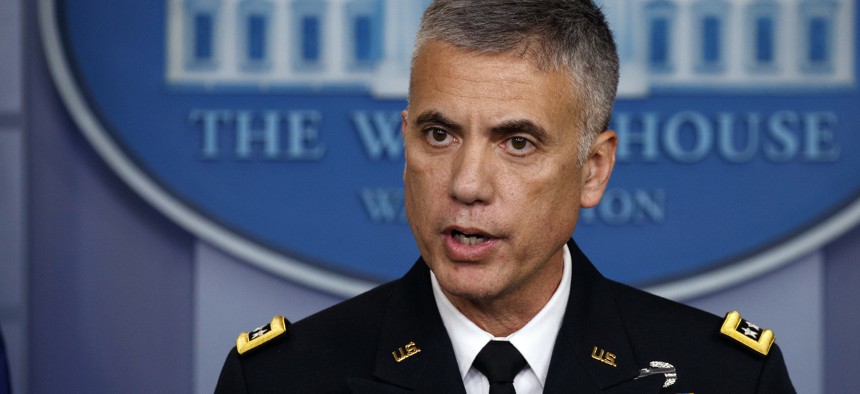
National Security Agency Director Gen. Paul Nakasone speaks during the daily press briefing at the White House, Thursday, Aug. 2, 2018 AP/Evan Vucci
Why NSA Has Its Eye on ‘Girls Who Code’
‘The future workforce needs to be representative of our nation,’ says the spy agency’s new director.
The highly secretive National Security Agency is taking advantage of a flood of employment applications to ensure a diverse workforce equipped for future innovation.
So declared Army Gen. Paul Nakasone, who was sworn in this May as the three-hatted lead of NSA, U.S. Cyber Command and the lesser-known 25,000-employee Central Security Service, which provides support to the military cryptologic community.
“NSA has bit of an advantage” over the technologically sophisticated private sector in that “our mission sells itself,” Nakasone said Thursday night at a dinner in Fairfax, Va., organized by the Intelligence and National Security Alliance. “We are defending our nation.”
That distinction has been made clear in recent employee town halls, he said. NSA employees “swear an oath to the Constitution, to an idea.”
The Ft. Meade, Md.-based agency has a retention rate of 92 percent, Nakasone reported, and receives some 17,000 applications per month — 40 percent of which come from sources that promote diversity. NSA is ranked among the top 20 employers for computer science graduates, he said, and has earned five external honors for excellence. NSA’s intern program attracts 9,000 applications a year from top colleges, of which 1,000 are considered and 280 invited for interviews, 70 percent of which get hired, he said.
“But it is the diversity of thought that fosters innovation,” he added, which is why, as the workforce goes through training and gains experience, his managers continue to push long-term to attract a workforce with diverse perspectives. That includes recruiting cyber experts from such organizations as Girls Who Code, he said. “The future workforce needs to be representative of our nation.”
“It was pretty shocking,” Nakasone added, when a show of hands at a town hall indicated that 70 percent to 90 percent of NSA staff started after the 9/11 terrorist attacks that are so central to the attitudes of older employees who lived through them. “For a whole of this work force, that’s a rapid amount of change,” which why it’s important to maintain “a constant focus on mission,” he said.
Because of the agency’s vital partnerships with industry, academia, research centers and foreign governments, NSA’s workforce planners are also making sure they keep “a strong body of contract officers with incentive pay so that they have opportunity to grow and succeed in that field,” he said.
Nakasone highlighted the “specialized skills” and unique capabilities of his team in creating “deep access to denied” areas of the globe to “give policymakers intelligence on battlefields in an actionable format in real time pace.” That also means “stealing secrets,” he said.
In a glimpse of the agency’s internal culture (its workforce size is classified, but is estimated at 30,000-40,000), Nakasone described a recent potluck employee lunch that “looked like a social event in the office” but was actually a demonstration to show how an electronic device could be hidden in a crock pot.
The knowledge gained from the U.S. experience in Iraq and Afghanistan fighting al Qaeda and ISIS, Nakasone said, is now being applied to meeting current threats. Those come primarily from China, for its intellectual property theft; Russia, with its meddling in U.S. elections; and North Korea, with its cyberattacks. He called them all “dangerous activities below the threshold of armed conflict.”
Nakasone said he would put NSA’s mastery of technology up favorably against that of any other agency or private-sector entity, noting a transparency effort that turns over the vast majority of discovered cyber system vulnerabilities to private-sector interests. NSA enjoys partnerships with 14 countries and companies for the pursuit of security in new technologies in areas such as artificial intelligence, machine learning, the internet of things, encryption and the coming 5G communications network.
Nakasone touted NSA’s Secure Wearable Authentication Gear that allows confirmed employee sign-ins to computers with a single tap rather than passwords. And he praised NSA’s low backlog of security clearance background checks, owing to the fact that the agency performs them in-house, usually “in less than 50 days.”
Asked about the public’s trust in NSA after the domestic surveillance controversies of recent years, Nakasone said his talks with past directors convinced him that “no security agency that doesn’t talk publicly will be accepted by the American public.”




